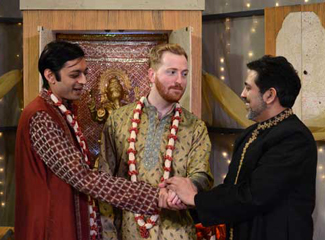
Despite having been written over four hundred years ago, Shakespeare's Romeo and Juliet is still invoked by star-crossed young romantics confronted with family opposition. The myth underscoring the courtship of the interracial same-sex sweethearts in Madhuri Shekar's A Nice Indian Boy, currently playing under the auspices of the Rasaka Theatre Company, has a shorter history, but resonates no less vibrantly.
Shekar's prototype is named Dilwale Dulhnaiya Le Jayenge (loosely translated, "Faint Heart Ne'er Won Fair Lady"). This immensely popular movie has screened continuously at the Maratha Mandir theatre in Mumbai since its release in 1995, making it the most successful to emerge from the "Bollywood" motion picture industry. It recounts the saga of London-bred Raj and Simran, who meet while touring Europe, fall in love and, after overcoming many obstacles ranging over several continents, are finally united in peaceful harmony.
The landscape through which Shekar's Indian Boy Naveen and Kheshav navigate true love's uneven road is crowded with allusions to "DDLJ" (as the film's title is commonly abbreviated). The smitten youths quote the film's dialogue to one another—in both English and Hindi—sing its songs and mimic its most famous scenes. Even the strategy Keshav employs to win the approval of Naveen's father parallels that of the intrepid Raj. Lord Ganesh, the Hindu god traditionally charged with helping those embarking on difficult journeys, is still a visible presence, but his powers take a back seat to those mandated by pop culture precedence.
Rasaka Producing Artistic Director Kamal Hans explains the appeal of DDLJ's enduring popularity, "This movie was one of the first to feature primary characters of Indian heritage, but to place them in international locales, so that people of Indian and South Asian descent everywhere can relate to their condition. As modern as Raj and Simran are, they still suffer conflicts arising from loyalty to the Indian customs that necessitates securing their parents' blessings."
Bollywood epics typically incorporate musical interludes into their action. These are also echoed in Nice Indian Boy—at one point, Keshav apologizes for not playing the guitar like his cinematic counterpart. In the early meetings with director Anna C. Bahow and Rasaka Associate Artistic Director Alka Nayyar, Hans reports that the playwright asked for, not full-scale vocals, but "tribute" music—a request that sound designer Matt Reich immediately set about researching.
"Almost every episode in the movie has a musical number in it." Hans assures me, "For ten years after the film was released, reception music for almost every Indian wedding included 'Mehendi Lagake Rakhna' ("Paint Your Hands With Henna and Wait For Me"). My whole family danced to it at my wedding!"
Were all the Indian Boy actors required to see the film? "I've watched it about twenty times, myself—it's available on Netflix" Hans says, "and Alka also has intimate knowledge of the screenplay, but we recommended that everyone familiarize themselves with it."
Virtually every ethnic group has their story of love triumphing over custom—from Abie's Irish Rose to Fiddler On The Roof—but many Americans remain sadly ignorant of South Asian culture. What should we bring with us to the play? "These themes, as you say, are universal. We hope that audience members who understand the inside references will experience an extra level of enjoyment, while those that don't will be sufficiently intrigued to delve further into the background of its setting."
A Nice Indian Boy runs at the Biograph Theater through March 8.
Mary Shen Barnidge
Contributing Writer

 Follow Us On Twitter
Follow Us On Twitter